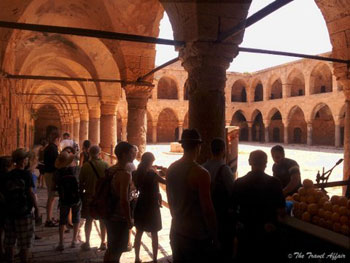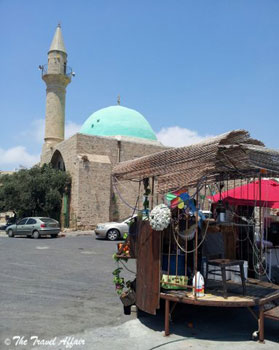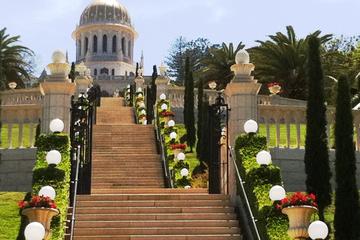
by Shelly Lachish
The ancient port of Acre (Akko in Hebrew, or Akka in Arabic), with its heavily fortified sea walls and imposing hilltop citadel, juts out defiantly from Israel’s coastline into the sapphire waters of the Mediterranean Sea. Standing at the city’s southernmost rampart, which is today equipped with a lighthouse and viewing platform, I cast my gaze over the golden fortress and down to the dramatic coastline where the waves break endlessly against the ancient sandstone walls that have withstood centuries of aggression.
 For millennia, this mediaeval promontory, one of the world’s oldest continuously inhabited locations, was a site of strategic military importance due to its commanding position on the trade route between Egypt and Syria. It is not surprising, therefore, that Acre’s history is a series of tumultuous invasions, defeats, victories and conquests that have played out over 1000’s of years by a multitude of conquering empires. Today, however, families of all nationalities and faiths live side by side in harmony in Acre, and the only shots heard over this UNESCO world heritage city come from cameras that belong to the army of tourists hungry to photograph this magnificent and intriguing historical site. Because even in this region of the world that teems with rich archaeological wonders, Akko stands out.
For millennia, this mediaeval promontory, one of the world’s oldest continuously inhabited locations, was a site of strategic military importance due to its commanding position on the trade route between Egypt and Syria. It is not surprising, therefore, that Acre’s history is a series of tumultuous invasions, defeats, victories and conquests that have played out over 1000’s of years by a multitude of conquering empires. Today, however, families of all nationalities and faiths live side by side in harmony in Acre, and the only shots heard over this UNESCO world heritage city come from cameras that belong to the army of tourists hungry to photograph this magnificent and intriguing historical site. Because even in this region of the world that teems with rich archaeological wonders, Akko stands out.
Acre’s historical and archaeological intrigue lies in the fact that the forts, mosques, churches, synagogues and labyrinthine alleyways of the Old City that date back 350 years to the Arab and Ottoman periods, conceal below them an exceptionally intact 800 year-old Crusader city that has only recently been discovered. Leaving behind the city walls and the spectacular views of Haifa harbor that they offer, I begin my exploration of this ancient underground city by delving into the Templar Tunnel, a 350 meters underground passage that was constructed by knights of the Templar order and led from their own fortress to the port.
 The tunnel, now restored and endowed with lighting, signage and a boardwalk alongside which rainwater flows freely to the sea, shrinks to just one meter in height before opening up to ground level at the resplendent Ottoman-built Pillar’s Inn (Khan Al-Umdan), a large multi-arched caravanserai, which was once the hub of international trade. From here, my explorations remain at ground level and lead me into the colorful Suk, the vibrant market street that forms the main thoroughfare of the Old City. It is midmorning and the market is crowded and bustling with activity as the locals attend to their shopping needs. Sweet stalls, vegetable stands, and shops selling clothing, ornaments, perfumes and other oriental artifacts, mix with bakeries, falafel shops, fishmongers and butchers stands, beneath which countless street cats make a healthy, if furtive, living. I amble slowly absorbing the sights and smells, and stop frequently to sample the delicious foods on offer.
The tunnel, now restored and endowed with lighting, signage and a boardwalk alongside which rainwater flows freely to the sea, shrinks to just one meter in height before opening up to ground level at the resplendent Ottoman-built Pillar’s Inn (Khan Al-Umdan), a large multi-arched caravanserai, which was once the hub of international trade. From here, my explorations remain at ground level and lead me into the colorful Suk, the vibrant market street that forms the main thoroughfare of the Old City. It is midmorning and the market is crowded and bustling with activity as the locals attend to their shopping needs. Sweet stalls, vegetable stands, and shops selling clothing, ornaments, perfumes and other oriental artifacts, mix with bakeries, falafel shops, fishmongers and butchers stands, beneath which countless street cats make a healthy, if furtive, living. I amble slowly absorbing the sights and smells, and stop frequently to sample the delicious foods on offer.
 The market street snakes past the beautiful emerald-domed Al-Jezzar mosque and towards the main citadel complex where archaeological excavations allow the visitor to literally descend through the layers of history. At the modern, and mercifully well air-conditioned, visitor center, I rent an audio guide and embark on my own discovery of these fascinating ruins. I am guided aurally through the existing fortress building, an Ottoman fortification that was built on the foundations of the ruined Crusader citadel, and then down to the underground Prisoner’s Hall, where during the period of British mandate hundreds of members of Jewish resistance movements (Haganah, Irgun and Lehi) were held prisoner and even executed. The tour then descends further underground to the recently excavated Knights’ Hall comprising a series of long narrow chambers with ten meter high vaulted ceilings and massive dividing walls connected by great arched entrances. Also preserved in time are the remains of a dungeon, living quarters, and a mediaeval church. Tantalizingly, some of the rooms of this impressive feat of 13th century architecture remain roped off with teams of archaeologists and engineers busy with ongoing excavations: a promise of more exciting discoveries for future generations of tourists to behold.
The market street snakes past the beautiful emerald-domed Al-Jezzar mosque and towards the main citadel complex where archaeological excavations allow the visitor to literally descend through the layers of history. At the modern, and mercifully well air-conditioned, visitor center, I rent an audio guide and embark on my own discovery of these fascinating ruins. I am guided aurally through the existing fortress building, an Ottoman fortification that was built on the foundations of the ruined Crusader citadel, and then down to the underground Prisoner’s Hall, where during the period of British mandate hundreds of members of Jewish resistance movements (Haganah, Irgun and Lehi) were held prisoner and even executed. The tour then descends further underground to the recently excavated Knights’ Hall comprising a series of long narrow chambers with ten meter high vaulted ceilings and massive dividing walls connected by great arched entrances. Also preserved in time are the remains of a dungeon, living quarters, and a mediaeval church. Tantalizingly, some of the rooms of this impressive feat of 13th century architecture remain roped off with teams of archaeologists and engineers busy with ongoing excavations: a promise of more exciting discoveries for future generations of tourists to behold.
 Ascending from the cavernous subterranean ruins of the Knights Hall I find myself at the entrance to the Hamam al Basha, a traditional 18th century Turkish bathhouse that remained in use until the 1940’s. Today the bathhouse has been reinvented as a light and sound experience in which a moderately humorous but slightly lengthy video presentation attempts to portray everyday life in the bathhouse culture. Despite the cheesy audio-visuals, the expertly restored, beautifully ornate bathhouse is well worth a visit. The entrance is a superb, domed-roof, marble room decorated with exquisite traditional ceramic tiles. A large marble fountain takes pride of place in the center of the room. At the base of the tiled walls there are small cavities, lockers of the past, which would one day have held the shoes and belongings of bathers. I take my sandals off and the chill of the 200-year-old marble floor feels wonderful on my weary feet. I proceed barefoot through a narrow corridor of smaller rooms where some of the more refined aspects of personal grooming and hygiene would have occurred, and into the main steam room – the social heart of the hamam. Here the domed ceiling has been perforated with geometrically placed holes through which hundreds of shafts of light penetrate to the raised marble massage area below. The dappled light is soothing and serene. Sculpted bronze figures and other relics placed around the large octagonal steam room help to recreate the authentic renowned feeling of communal relaxation for which the Turkish hamams were famous.
Ascending from the cavernous subterranean ruins of the Knights Hall I find myself at the entrance to the Hamam al Basha, a traditional 18th century Turkish bathhouse that remained in use until the 1940’s. Today the bathhouse has been reinvented as a light and sound experience in which a moderately humorous but slightly lengthy video presentation attempts to portray everyday life in the bathhouse culture. Despite the cheesy audio-visuals, the expertly restored, beautifully ornate bathhouse is well worth a visit. The entrance is a superb, domed-roof, marble room decorated with exquisite traditional ceramic tiles. A large marble fountain takes pride of place in the center of the room. At the base of the tiled walls there are small cavities, lockers of the past, which would one day have held the shoes and belongings of bathers. I take my sandals off and the chill of the 200-year-old marble floor feels wonderful on my weary feet. I proceed barefoot through a narrow corridor of smaller rooms where some of the more refined aspects of personal grooming and hygiene would have occurred, and into the main steam room – the social heart of the hamam. Here the domed ceiling has been perforated with geometrically placed holes through which hundreds of shafts of light penetrate to the raised marble massage area below. The dappled light is soothing and serene. Sculpted bronze figures and other relics placed around the large octagonal steam room help to recreate the authentic renowned feeling of communal relaxation for which the Turkish hamams were famous.
The audio tour ends and I surface from the relative cool and peaceful spaciousness of the bathhouse into the blinding heat of afternoon Mediterranean sunshine. Suddenly, the call of the muezzin sings resounds over the city, broadcast from speakers mounted at the top of Al-Jezzera mosque’s minaret. “Allah Akbar! Allah Akbar!” The distinctive melancholy melody calling the faithful to prayer casts an ethereal atmosphere over this mysterious city, and immediately transports me back to historic times. Undeniably, it is this combination of above ground beauty, hidden underground treasures, a thriving cultural life, and buried secrets yet to be discovered that ensures Acre will remain a living historical monument for years to come.

To the North of Israel Haifa Acre and Rosh Ha-Nikra Private Tour
If You Go:
♦ Acre is about 50 minutes’ drive from Haifa, or 1 hour and 45 minutes’ drive from Tel Aviv. Trains run every 20 minutes in peak times from either Haifa or Tel Aviv. There are also direct buses from Haifa and Nazareth to Acre.
♦ A full ticket entrance to the old city and the Turkish baths costs around $12 and includes the audio tour. Entrance to the Al-Jezzar mosque is extra.
♦ For more information: www.akko.org.il
About the author:
Shelly Lachish is an ecologist and freelance writer who has travelled extensively in Israel, Europe and Oceania. She currently resides in Oxford, England, where she moonlights as an academic. She blogs about her travels at thetravelaffair.net. This is her first contribution to Travel Thru History.
Photo credits:
All photos are by S. Lachish, and may be used under creative commons license.
The walled port city
The Pillar’s Inn (Khan Al-Umdan)
Women in the suk
Al-Jezzera mosque
Turkish bathhouse



Leave a Reply
You must be logged in to post a comment.